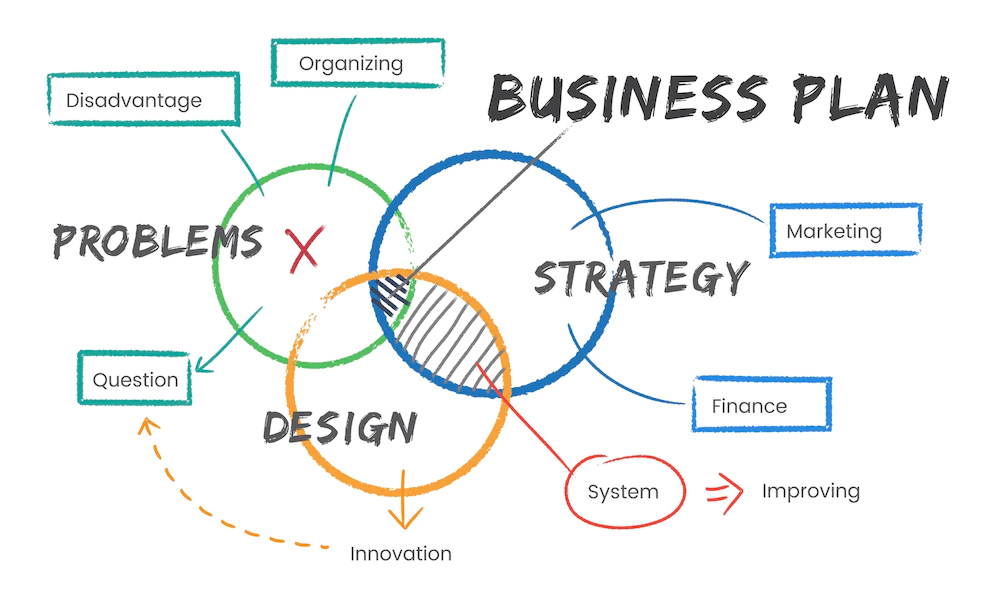Whether you want to start a business or grow one, you’ll need a loan. However, it’s not always easy to get a loan from a bank or other lenders. You will need a few key things to make your case and get the loan you need, one of which is a business plan. A business plan shows lenders that you are serious about your business and provides them with a roadmap of what you plan to do.
Lenders should see that you have a well-thought-out business plan before they will take you seriously. Because lenders want to make a profit, they will often loan money only to those businesses that have a good chance of making money in return.
In this article, we’ll provide a complete roadmap on how to write a business plan for a loan. So if you are interested in getting a loan for your business, read on!
Table Of Content
What Does a Successful Business Plan Include?
What Are the Types of Business Plans?
How to Write a Business Plan to Get Approved for a Loan?
What is a Business Plan?
A business plan is a written document that describes an idea for a product or service, the market it will serve, and how it will be profitable. It also outlines the steps needed to achieve the goals of the business.
A business plan often includes
- Market research
- Financial projections
- Marketing strategies
- Operational plans
- Business goals
- Exit strategies
Having a business plan is essential for any entrepreneur who wishes to turn their idea into reality.
Whether it is getting approved for a loan, seeking investors or partners, or simply remaining organized and focused, having a clear business plan is vital for the success of any business.
What Does a Successful Business Plan Include?
Every business is different and has different goals and objectives, however, all successful business plans have a few key elements:
- An Executive Summary
- A Company Description
- A Market Analysis
- A Service or Product Line
- Marketing and Sales Strategies
- Financial Projections
- Funding request
- Appendix
Let’s take a closer look at each of these elements of a business plan.

Executive Summary
An executive summary is a brief overview of any business plan. It should include your company’s mission statement, a description of your products or services, your target market, and your growth strategy. The executive summary should be short and to the point- no more than two pages. In simple words, an executive summary should answer the question: “What is this business and what does it do?”
Company Description
The company description section of your business plan should provide an overview of your company’s history, structure, and ownership. This section should also include your company’s mission statement and a brief description of your products or services. This should also include your target market and your growth strategy.
Market Analysis
As the name suggests, the market analysis section of your business plan should analyze your industry and the markets you serve. This includes a description of your target market, an analysis of your competition, and an overview of the economic trends in your industry. It is a crucial part of a business plan because it shows the lenders that you have a clear understanding of the market you are entering and that your business has a good chance of succeeding.
Service or Product Line
In this section of your business plan, you should describe your company’s products or services in detail. This includes a description of your unique selling proposition, an overview of your product development process, and a description of your manufacturing process. This section should also include the pricing of your products or services. Keep the pricing reasonable and competitive so that lenders will see that your business has a good chance of making money.
Marketing and Sales
The marketing and sales section mainly represents these 3 aspects of your business plan
- How will your target market find out about your products?
- Your sales methods
- Your growth strategy
As you can see, the marketing and sales section of your business plan should include a detailed description of your marketing and sales strategies. This includes a description of your target market, your sales methods, and your growth strategy. You will need to show the lenders that you have a well-thought-out marketing and sales plan before they will loan you money.
Financial Projections
Now, this is one of the most important sections of your business plan. The financial projections section should include a detailed description of your company’s financial situation. This includes
- Your income statement
- Expenses
- Balance sheet
- Cash flow statement
You have to properly project your company’s financial situation to get a loan from the lenders. They will want to see that you have a good chance of making money and that you are not a high-risk investment. Be honest with your projections and don’t try to inflate your numbers.
Funding Request
As you can tell by the name, the funding request is where you ask the lender for money. This section of your business plan should include how much money you need, what you will use it for, and how you will repay the loan. Be specific in this section and don’t try to “sell” the lender on your business. Just state the facts and let them make their own decision.
Appendix
The appendix is where you include any additional information that you think will be helpful in your business plan. This can include things like your resume, letters of recommendation, financial statements, market research, and anything else that you think will help your case. If you have a lot of information that you want to include, you can put it in the appendix and refer to it in other sections of your business plan.

What Are the Types of Business Plans?
Now that we know what goes into a business plan, you may be wondering what types of business plans there are. There are mainly 6 types of business plans.
Start-up business plans
As the name suggests, start-up business plans are for businesses that are just starting. These types of business plans are usually shorter and less detailed than other types of business plans. The reason for this is that start-ups don’t have a lot of history to include in their business plans. They also tend to be riskier than established businesses, so the lenders will want to see a well-thought-out plan before they loan you money.
Internal business plans
Internal business plans mainly target a specific audience within the company. For example, an internal business plan for a sales team would be different from an internal business plan for the marketing department. Internal business plans are usually shorter and less detailed than other types of business plans because they are only meant for a specific audience.
Strategic business plans
Strategic business plans are one of the most effective types of business plans. This is because strategic business plans project a high level of detail on how the business will achieve its goals. Strategic business plans are usually longer and more detailed than other types of business plans. The reason for this is that they need to be very specific to be effective.
Operational business plans
As you can guess by the name, operational business plans focus on the operations of the business. This type of business plan includes things like your marketing and sales strategies, your production process, your financial projections, and your management team. In simple words, operational business plans mainly focus on the day-to-day operations of the business.
Growth business plans
Growth business plans are for businesses that are looking to expand. This type of business plan includes things like your growth strategy, your expansion plans, your financial projections, and your marketing and sales strategies. These business plans are mainly for businesses that are established and looking to grow their customer base or expand into new markets.
Feasibility plan
And lastly, we have feasibility business plans. When a company is thinking about starting a new business, it might write a feasibility plan. This plan will help them figure out if it is a good idea to start this new business and what they need to do to make it successful. It shows lenders that you have thought through your idea and that you have a plan for making it happen.
Read Also: How to Get a Loan for Liquor Store?

How to Write a Business Plan to Get Approved for a Loan?
So now we know one of two things about business plans- let’s find out what goes into them and the different types of business plans. But how do you write a business plan to get approved for a loan? Here are the key steps:
Do your research
To write a well-rounded business plan, you need to do your research. This means understanding your industry, your target market, your competition, and your own business. You can use books, articles, websites, and even talk to experts in your industry to get a better understanding of all of these things.
You can also attend trade shows and conventions to learn more about your industry. The key is to have a good understanding of all the different moving parts before you start writing your business plan.
Know your audience
Before you start writing your business plan, you need to know who your audience is. This is because your business plan needs to be tailored to them. Are you writing it for yourself? For your management team? For potential investors? For a bank? Each audience will be looking for different things in your business plan, so you need to make sure you include the information that is most relevant to them.
Decide on the type of business plan you need
As we mentioned before, there are different types of business plans for different audiences and purposes. So, before you start writing, you need to decide on the type of business plan you need. Do you need a simple internal business plan? A more detailed strategic business plan? Or a feasibility study to see if your new business idea is viable? Once you know the type of business plan you need, you can start writing.
Financial projection is the key
No matter what type of business plan you are writing, the financial projection is always the key. This is because your financial projections will show lenders whether or not your business is a good investment. They will also give you an idea of how much money you need to get started and how much you can expect to make in the future. So, make sure you spend a lot of time on your financial projections.
Keep it short and sweet
No one wants to read a 100-page business plan, so, make sure you keep your business plan short and on point. Only talk about necessary things and exclude anything that is not relevant to your audience. Write a 20-30 page business plan for most audiences, and a shorter executive summary for investors or lenders.
Review your business plan
Once you have finished writing your business plan, review it several times. Make sure there are no errors and that everything flows well. You can also ask someone else to read your business plan and give you feedback. After you have reviewed and edited your business plan, you will be ready to show it to your audience.
Get professional help
Writing a business plan can be a daunting task for beginners so it’s always a good idea to get professional help. There are many business plan writing services that can help you get started. They will have template business plans and software that will make the process easier for you so, if you need help, don’t hesitate to ask for it.
Get feedback from others
After you have written your business plan, it is important to get feedback from others. This can help you improve your plan and make it more likely to be successful. Talk to experts in your industry, ask for feedback from your target market, and get input from your team. The more feedback you can get, the better so make sure to take all of the feedback into consideration and use it to improve your plan.

Streamline your business with Octopos– A Complete POS System with Big Boys Tools without the Big Price
It is a lot more than a point of sale. Octopos is easy and intuitive for you and your staff to use. Yet you get all these sophisticated tools to manage inventory, track and engage customers, get meaningful insights into your business, and much more.
Why Do You Need a Business Plan to Get a Business Loan?
A business plan outlines a company’s goals, strategies, and challenges. It is an essential document for entrepreneurs seeking funding from investors or lenders.
A business plan provides evidence that the entrepreneur has thought through key aspects of running their business and can effectively manage it.
When submitting a loan application, lenders typically request to review an up-to-date business plan as part of the process.
The business plan provides lenders with insight into how an entrepreneur intends to use the loan funds, the profitability of their venture, and the repayment plan.
A good business plan needs to focus on four key areas: market research; financial projections; marketing strategies; and operational plans. It should also detail expected risks, proposed exit strategies, and other important considerations.
Having a business plan helps entrepreneurs to identify potential risks, develop strategies for managing them, and attract investors or lenders who can finance the venture.
It also serves as an operational tool to help entrepreneurs make informed decisions on how their businesses should run.
In addition to providing insight into the entrepreneur’s capabilities, a business plan is beneficial for loan applications because lenders want to see that the venture can generate enough cash flow to cover any debts they are taking on.
A detailed financial section of the business plan helps to demonstrate this.
Most lenders will not provide a loan without seeing a business plan. A well-written and comprehensive plan provides the necessary information lenders need to assess the risk of lending money to the venture.
It also serves as an effective tool for entrepreneurs to track their progress and stay focused on their goals.
By providing evidence of their capabilities and showing that their venture has potential, an entrepreneur’s chances of being approved for a loan significantly increase.
A well-thought-out business plan is essential for obtaining financing and should not be overlooked when applying for a loan.
Conclusion
Writing a business plan is an important step in starting your own business. It can help you get funding, attract investors, and make sure you are on the right track. So, take the time to write a good business plan and make sure it is tailored to your audience. We hope this article has helped you get an idea of how to write a business plan for a bank loan. If you feel confused or stuck, don’t hesitate to ask for help from a professional. Good luck!
Let octopos help you to maintain your business with ease. Get started today!

